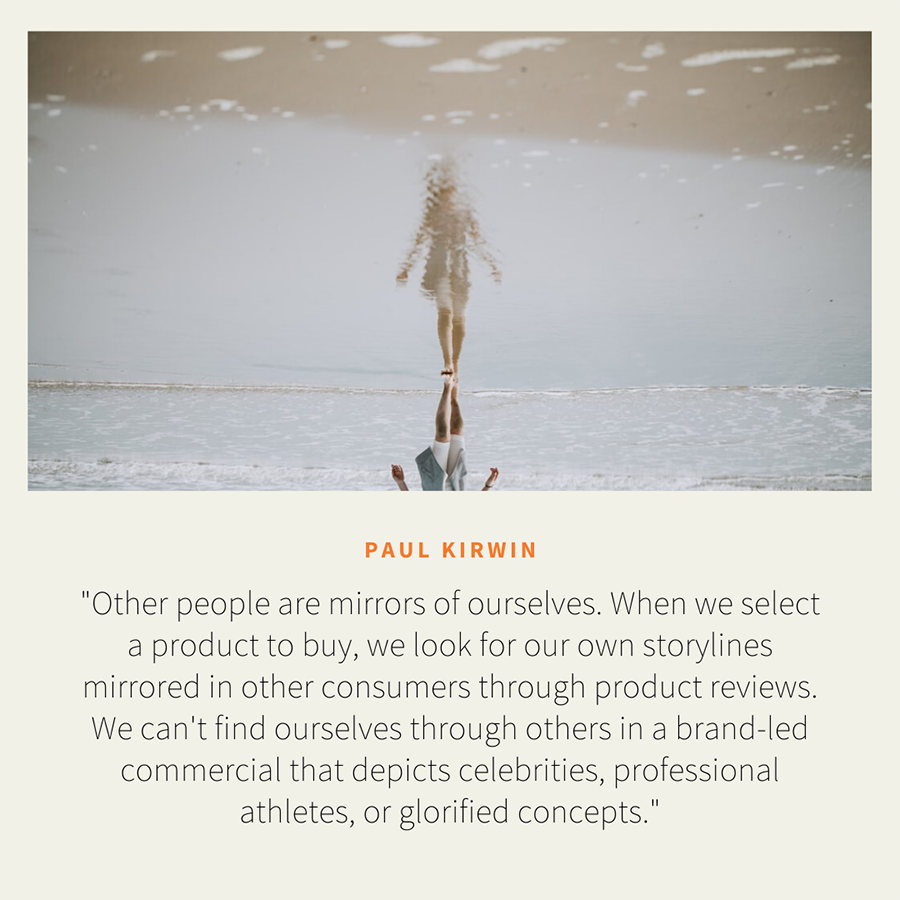We received a lot of feedback from last week’s article stating 78% more people trust product reviews than ads. If you found that number to be astonishing, take a look at what major companies are spending on ads:
- Procter & Gamble ad spend: $6.71B (Bizjournals)
- L’Oreal ad spend $2.2B (Howmuch.net)
- The North Face ad spend: $13M (Statista)
 The Man or Woman in the Mirror
The Man or Woman in the Mirror
All this money for just 4% trust. If I told you only $.04 of each $1.00 you spent on an ad would actually go toward the ad, would you go for it? In fact, using this logic, I would go so far as to say these funds are actually taking money out of each customer’s wallet.
And what about connection? I concede that some ads conjure up great feelings about your brand (think Nike’s “Dream Crazier” ad) and certainly have their place, but where is the connection with each individual consumer?
Digital ads and websites today are all about personalization to meet the needs of a diverse audience. So why break the bank on an ad when it only tells a single storyline?
3 Ads That Fail to Connect with a Wide Breadth of Consumers’ Personal Stories (aka what makes them buy)
1. L’Oreal Excellence Creme Commercial
Take a look at a 2019 commercial from L’Oreal. There is much to unpack here. First and foremost, are we the consumer to believe that Celine Dion dyes her own hair from the box? I’m pretty sure the Queen of Adult Contemporary music has an entourage of stylists at her own personal whim giving her plenty of “R.E.S.P.E.C.T.”.
What’s the story consumers are really looking for with L’Oreal?
- Gray coverage. In a single product page on Amazon, there are 69 consumer stories mentioning gray coverage. These are found throughout the Reviews and Q&As. Contrast this with Miss Dion, whose color appears perfectly not-gray before she applies the cream.
- Ease of use. 35 individual consumer comments mention how easy this product is to use. Now, it does look easy in the commercial when Celine applies the cream, but again, are we to really believe she is using this stuff herself?
- Color match. There are over 140 mentions of color, shade and matching keywords for shoppers to mine through to find that person who mirrors their experience. Celine? Looks like she’s going with color number 7, “dark blonde”. According to L’Oreal’s website, there are 37 color options. So once again we see an ad depicting a single storyline when there are many to be told.
2. The North Face Never Stop Commercial
This is a really cool ad. But does that mean it achieves the goal of consumer connection? Perhaps better than the L’Oreal ad above, but it still misses the mark. It depicts big line backcountry skiers, paragliders, bridge jumpers, oceanic workers, ice climbers, world travelers and photographers. So, yes, it does diversify its consumer depiction, but it’s still grandiose. The reality is that most consumers wearing The North Face clothes are doing so in an everyday capacity. In the sporting goods this is known as “athleisure”: some athletic wear, some leisure wear.
What’s the story consumers are really looking for with The North Face?
- Fit. We compiled two highly reviewed products (one men’s, one women’s) and there are 150+ reviews about size and fit. Showing professional athletes and extreme workers in a commercial doesn’t connect shoppers to answers for their fit concerns.
- Warmth. Over 100 reviews mention cold days or the warmth of the coat, but not in the capacity you might think. They aren’t talking about that time they went ice fishing in the Arctic. It’s more like, “great in wet cold (Chicago lakeside)!”
- Quality. Many, many reviewers mention different quality aspects of these coats. From the feathers falling out to the packability, each of these storylines is unique and speaks to a need or use case of a future shopper.
3. Mr. Clean’s “You Gotta Love a Man Who Cleans” Commercial.
This ad made most people laugh, many people smile, and some people cringe. Mr. Clean’s Super Bowl ad debut surely cost a pretty penny, so did it connect with what consumers really want? Sounds like what consumers want out of their cleaning products is to know they work. They don’t want to laugh or be a part of a gender movement.
What’s the story consumers are really looking for with Mr. Clean?
We took a look at one highly reviewed Mr. Clean product, the Magic Eraser. Turns out, some of the top issues reviewers wrote about had nothing to do with the iconic bald man at all:
- Scuff marks
- Stainless steel
- Soap scum
Rather, shoppers have a use case in mind when they are looking for this product. Think: “my pet is rubbing against the wall, can this fix it?”, or “my kid leaves fingerprints on my white door, can this fix it?”. They find these storylines in the reviews as quickly and easily as they click the “Buy Now with 1-Click” button.
What Matters When it’s Decision Time for Consumers
As mentioned, we got a lot of feedback on our blog about ad trust. One was from a friend, a VP of Marketing with a big résumé. He wrote that advertising was great because you could craft a strong message and control the distribution. True. And if your goal revolves around a big branding message like “Dream Crazier” then television advertising makes sense.
However, when consumers want to get down to brass tacks, they are looking for a product that meets a personal need: hair color that is the perfect match; a down jacket that can get them through a New York City winter; a cleaning product that can tackle toddler fingerprints. “Dream Crazier” attracts consumers to the brand. Customer-generated reviews bring them closer to a purchase.

